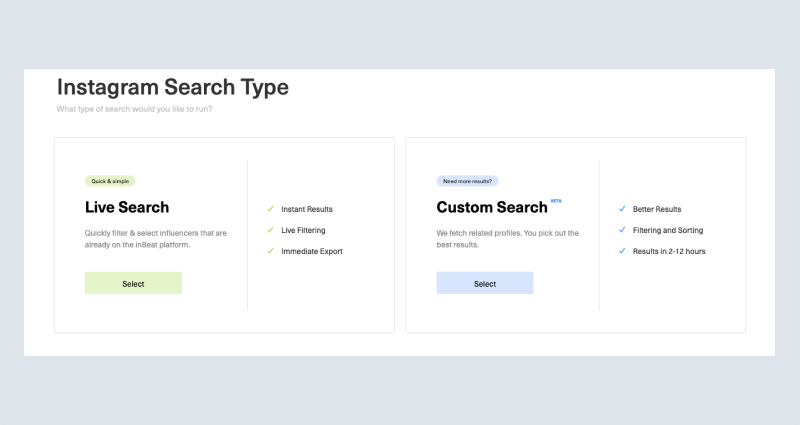Create high quality UGC - Try Showcase for free
Now more than ever, brands are turning to social media influencers to market their products.
Micro-influencers are becoming a crucial part of the process! A verifiable cash cow for many companies.
Micro-influencer marketing is highly effective at promoting your brand compared to traditional marketing tactics.
Generic advertisements may miss a considerable chunk of your target audience.
You’re going to see a massive gap between you and your competitors unless you start engaging with micro-influencers!
Brands are getting wise about the influencer marketplace, but there’s a lot of fumbling about still.
Finding the best micro-influencers can seem like looking for a needle in a haystack.
Luckily, we’re here to help. There are tactics and tools every brand can use to streamline the process.
Check out these reliable methods to finding micro-influencers in 2024!
Finding Influencers by Keywords & Hashtags
Keywords & hashtags hone the hunt for your influencers.
They sort through the sea of profiles to find influencers specific to your niche.
They’ll even find micro-influencers that already engage with your brand.
Keywords & hashtags are also the best manual way to find influencers, perfect for companies that aren’t looking to spend the extra budget on an influencer agency or subscription services.
Rather than defining your marketing strategy by yourself, hashtags give you a window into social narratives surrounding your product.
They’ll help you understand current trends to pattern your marketing campaign to perfection.
Instagram & Twitter use hashtags heavily, but you’ll have to put in extra work on Facebook, which utilizes them less.
YouTube uses keywords very much like a Google search.
A quick google search will quickly reveal common hashtags relative to your industry.
Here are some types of hashtags Google might miss:
1. Branded Hashtags
The most self-explanatory hashtags. These are hashtags that directly reference your brand.
To utilize them to their full potential, use branded hashtags with the product label—for example, #Imac for Apple computers.
2. Niche Specialized Hashtags
Every niche market has a unique vernacular used exclusively by its followers.
Niche specialized hashtags are terms organically created by your target audience.
For example, #sendit for winter sports activities (which means someone who sends themselves off a cliff or a jump while skiing or snowboarding.)
Investigate what hashtags people in your niche are using for social posts, then use them for your search.
3. Seasonal/Promotional Hashtags
Hashtags related to holidays & special occasions won’t show up on a Google hashtag search, but they could be the most relevant keywords for your brand.
Many companies count on seasonal events & promotions to market their products—for example, #mothersdaygifts.
4. Location Hashtags
For mom & pop shops, travel brands, & community businesses, location hashtags work like a charm!
Don’t discredit location hashtags before you try it out.
Finding Influencers Through Tagged Content
Searching the tagged section is one of the best ways to find influencers on Instagram.
Unfortunately, this feature isn’t available on other social media sites, but that should make you want to utilize the platform!
Instagram now captures a considerable chunk of the market.
Influencers that tag themselves in the content on your brand or your competitors will appear in the “tagged” section.
Tagging gives you a direct feed of influencers that may fit your niche from the start.
Go to the brand’s Instagram page and click on the tagged tab right above the pictures.
All the people who tagged the brand in their post will appear, and you can investigate influencers from there.
Using the tagged section can be a little tricky unless you know exactly what to look for.
There’ll be tons of promotional posts created by the brand to avoid. Look for influencers with over 200 likes on average per post.
Finding Recommended Influencers
Why do any heavy lifting? Some social media sites practically gift wrap your next influencer.
YouTube & Instagram both have features that recommend parallel accounts of influencers you already know; influencers you collaborate with.
This is an excellent option if you find an influencer you like, but they don’t quite meet your brand needs.
Here’s how to find them on Instagram:
- Locate an Influencer’s profile in your niche.
- Click the “arrow” next to the “Following” or “Follow” icon.
- A row of suggested accounts will appear to scroll through.
- Select “see all” to view every suggested profile.
Here’s how to find them on YouTube:
- Locate an influencer’s channel in your niche.
- Click the “Channels” tab on the main page.
- Relevant other channels will appear.
- From there, you can determine if the other channels fit your needs.
Finding Influencers Through Google
Let’s be honest - this is probably the first way that many brands will look for an influencer.
“Googling” is now a conditioned response in us, but using it to find your influencers may not yield the best results.
Google allows you to narrow the search with advanced options, but, from our experience, they filter too many influencers out.
Elite, expensive influencer accounts are going to show up at the top.
You can leverage the Google search to start finding influencers in your niche and work your way from there.
Google search “your Niche” + Top Influencers + (preferred Social Media Platform)
Lists of the top influencers in your niche will appear first.
You can check out the top profiles and then work your way down through suggested accounts, tagged content, or relevant hashtags in their posts.
Finding Influencers Using Tools
Many different software tools on the market will make your life easier while finding a micro-influencer.
Manually searching for influencers is time-consuming and can get frustrating.
Influencer search tools give you a streamlined process with detailed analytics like engagement rate & fake followers.
You’ll run across tools based on databases or proprietary platforms. Databases tend to include massive amounts of influencers that aren’t verified. Platforms include fewer influencers qualified by the platform.
Some Influencer platforms transition your search and automate the entire influencer marketing process, from contacting & contracting influencers to setting up full-blown marketing campaigns.
Influencer search tools have advanced filtering options based on location, hashtags, follower count, niche, and more.
Tools come in both paid and free options.
Most tools have a free trial if you want to test them out. Here are some of the top tools out, so you know which one is the best option for your brand!
Inbeat.co

Our Influencer search tool is the #1 way to find a micro-influencer for your brand on Instagram or TikTok!
Our proprietary platform features robust features to pinpoint influencers that match exactly what you are after.
All the influencers featured by our tool have been verified and approved!
Search micro-influencers by hashtag, mention, username, & bio keyword. If you don’t have any hashtags in mind, our system will recommend your niche’s best ones.
Set your search parameters to match the influencer’s username, bio, and posts to refine the results.
Once you’ve established search criteria, a list of matching influencers will populate.
You can export the influencer list into an excel spreadsheet that contains contact details to get the ball rolling with your top picks.
Modash

For brands searching for influencers across the globe, Modash is a handy tool!
You can find influencers across a variety of social media platforms, including YouTube.
Modash features a range of influencer search filters, like subscriber count, location, language, and engagement rate.
The cool thing about Modash is its ability to filter by audience, so you can confirm that the influencer’s target audience is the same as yours.
Filter audience by age, gender, location, and language.
Modash rigorously checks each influencer in their system for quality assurance. The platform offers influencer campaign monitoring & analytics to gauge the influencer’s performance.
Heepsy

For brands looking to save cash, Heepsy features a free account!
Custom tailor your search to find Instagram and Youtube influencers in your niche.
The Heepsy database includes nearly an unlimited number of influencers with fake follower analysis and authenticity score.
You’ll have to change to the paid version to get access to that many influencers, but it might be worth it after trying Heepsy out.
Keyhole

You can always use a hashtag search tool like Keyhole, which will track keywords and sort results by engagements or likes.
That way, you know which hashtags are going to lead you to your ideal influencer. Keyhole offers so much more, too, like social listening to get a picture of your influencer’s impression on your audience.
Finding Influencers by leveraging Your Community
The best tool any company has is its people.
Leverage everyone in your organization and see who they follow on social media.
Chances are, they have someone on their feed that might make a good micro-influencer for your brand.
You don’t have to search the internet high and low. All you have to do is reach out asking for referrals!
